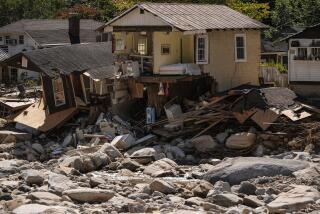A Call for National Flood Response Teams
Rep. Brian Bilbray (R-San Diego) is a former lifeguard who recently took a plunge into the Potomac River to take part in a swift-water rescue training exercise.
Nancy Rigg is a Los Angeles documentary filmmaker and writer whose fiance was swept to his death by a flood-swollen Los Angeles River two decades ago.
Out of their different experiences, they will urge a congressional panel this month to recommend that federal disaster officials create a national âmutual aidâ system of flood and swift-water rescue teams.
The teams would respond to floods in the way that the Federal Emergency Management Agencyâs urban search and rescue teams responded to the Northridge earthquake and Oklahoma City bombing. Flood rescue teams would be deployed in advance of major storms.
The hearing is timely because of criticism that search and rescue teams were dispatched to flood-ravaged North Carolina after Hurricane Floyd last year without basic equipment such as life jackets. One team went to a sporting goods store during the flooding to buy inflatable boats. At the same time, flood rescue teams were available in California and elsewhere but were not called up.
A political rescue, however, may be at hand.
FEMA director James Lee Witt said that he is âdefinitely interestedâ in a national flood rescue program.
FEMA teams are trained to rescue victims of collapsed buildings. But most are not trained or equipped for flood rescue because that is currently not part of their mission, according to FEMA.
âYou donât send the same type of people into a flood that you would an earthquake,â Bilbray said. âThe federal bureaucracy needs to understand that one size does not fit all natural disasters.â
*
The hearing is tentatively set for Feb. 16, one day before the 20th anniversary of the death of Riggâs fiance, Earl Higgins.
Higgins was attempting to save a boy who waded into the Los Angeles River to retrieve his bike. The boy survived. But Higgins was swept 30 miles downstream âpast rescuers who had neither the training nor equipment to help,â Rigg said. His body was recovered nine months later in Long Beach Harbor.
Since then, Rigg has been nagging government officials from city halls to Washington to establish the water rescue teams.
Along the way, she encountered Bilbray, who as a San Diego County supervisor helped rescue people and animals during heavy flooding in the Tijuana River Valley in 1993.
And last fall, he donned a wetsuit, fins, life jacket and strobe light (âso everyone knows where you areâ) and joined the 16-member San Diego Lifeguard Service River Rescue Team in a night drill in the Potomac.
âItâs what every congressman does on his night off,â he joked.
For those seeking federal support for flood rescue teams, a congressman in the water meant the swim of a lifetime.
Lt. Marshall Parks of the San Diego Lifeguard Service and Deputy Fire Chief Steve Miller of Cabin John Park, Md., which hosted the training exercise, sent Bilbray their proposal.
âTime and again, news broadcasts show scenes of rescuers who appear to be poorly equipped and trained unnecessarily risking their lives and the lives of victims while attempting what would be a routine rescue effort for a skilled flood rescue team,â they said in a letter.
âAn issue of concern is the timeliness of the federal governmentâs response,â they added. âFlooding, with the exception of dam or levee failure, is a natural disaster which can be predicted with enough certainty to allow predeployment of rescue resources. Yet FEMA has chosen to be reactive rather than proactive in dispatching resources. This has resulted in loss of life and property.â
*
California, as usual, has been the trendsetter.
Many California cities and counties have swift-water rescue teams. And California has a coordinated statewide program in which swift-water rescue teams--including some of the California-based FEMA teams--have been sent from one part of the state to another to help rescue flood victims.
California teams should be available to help other regions of the country, and other regions of the country should have flood rescue teams, Bilbray and Rigg said.
In the hearing before the House transportation and infrastructure oversight, investigations and emergency management subcommittee, video footage of people trapped by floods or swept into rivers is expected to be shown.
No legislation has yet to be drafted. A Bilbray aide said the congressman is waiting for the outcome of the hearing to determine what legislation, if any, is needed.
Congressional approval probably will be required for federal funds to equip and train teams and pay for them to respond to flooding disasters. No estimate of that cost has been made.
Rigg said that California has shown that the teams can save lives.
During the 1980 floods, before Los Angeles County had swift-water rescue teams, 25 people died, she said. During the 1998 El Nino storms, the teams rescued more than 100 people, and none died.
âOur program works,â she said. âBut it needs to be replicated nationwide.â
More to Read
Get the L.A. Times Politics newsletter
Deeply reported insights into legislation, politics and policy from Sacramento, Washington and beyond. In your inbox three times per week.
You may occasionally receive promotional content from the Los Angeles Times.











